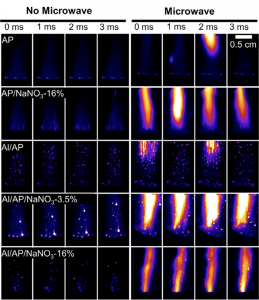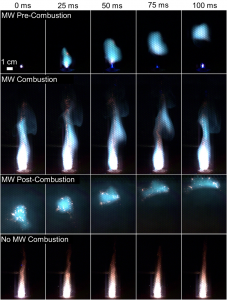We put a lot of things in a kitchen microwave, from Hot Pockets to leftover lasagna. But what about rocket propellant?
That’s essentially what Travis Sippel and his team are doing in a Young Investigator Project (YIP) with the Air Force Office of Scientific Research. More specifically (and more safely), they are testing methods to dynamically control the combustion of a solid rocket propellant by applying microwave energy.

Multiple phases with one goal
Currently, the propulsion industry relies on both solid and liquid rocket engines. Along with the difference in phase of the propellant, these two rocket types have different strengths and weaknesses.
While a solid rocket engine is more efficient in terms of thrust-per-weight and is far simpler than a liquid rocket engine, unlike a liquid rocket engine, it cannot be throttled midflight. With a liquid rocket engine, you can pump more or less fuel and oxidizer into the combustion chamber to change the engine’s thrust. However, in a solid rocket motor, the thrust history a solid rocket engine provides during a flight mission is fixed during the design and fabrication of the rocket motor and cannot be changed.
That is why Sippel, associate professor of mechanical engineering, and his team are applying microwave energy to rocket propellant. They are working to understand how electromagnetic fields, specifically microwave fields, can be used to dynamically control the combustion of a rocket propellant.
The answer to this question lies in the chemical makeup of the propellant. Sippel and his team have worked to develop a number of propellant formulations that enable interaction with microwave energy. Some of these techniques employ the addition of easily ionized materials to the propellant to allow microwave energy to interact with the propellant flame.
Others employ 3D printing of propellants that contain conductive microwave antenna features or the production of microwave-tuned energetic additives by wrapping clusters of nanoscale energetic materials with graphene oxide or reduced graphene oxide to produce solid propellant ingredients whose microwave absorptivity is thermally sensitive and enables absorption of microwave energy specifically at the surface of a burning or extinguished propellant.
By having the ability to switch the material at the top of the burning surface of the propellant from reactive to nonreactive and back again, the solid rocket engine can be throttled with the same versatility as a liquid engine. Sippel and his collaborators have used these techniques to increase the burning rate of a propellant by up to 60%, which allows them to reignite extinguished propellants.

A synergistic relationship
In the long term, having the ability to dynamically control the combustion of solid rocket propellant could make solid rocket motors, with their high thrust-to-weight ratio and simpler fabrication, more useful for a variety of launch missions.
In the short term, Sippel hopes some of his group’s rocket propulsion research may see earlier application by propelling Iowa State’s rocketry club, CyRoc, into the limelight.
Each year, CyRoc members build a rocket and travel to New Mexico to compete in the Spaceport America Cup against other rocketry teams from universities across the globe. The competition is the perfect place to test new and innovative methods.
Sippel and his team are limited in the tests they can run because they cannot launch rockets, so CyRoc’s competition rocket can be a proof-of-concept activity that models the researched effect of a flight-weight system as opposed to simply burning a piece of propellant the size of a pencil.
“It’s a synergistic relationship,” Sippel said. “The rocketry club is looking for ideas to test new techniques, and our research project needs the technology to be proven and pushed along with an actual rocket.”
Under one umbrella
As a member of the Center for Multiphase Flow Research and Education (CoMFRE), Sippel’s research has greatly benefited from collaborations with other Iowa State CoMFRE members.
Sippel explained that James Michael, assistant professor of mechanical engineering, has been instrumental in the team’s understanding of plasma and conducting high fidelity laser diagnostic measurements of the complex combustion systems. Shankar Subramaniam, professor of mechanical engineering, has helped with modeling systems for these propulsion techniques
These collaborations have led to new opportunities for the team as well. The three, in collaboration with the Naval Surface Warfare Center – Crane, have started a new project for the Strategic Environmental Research and Development Program on electromagnetically controlling the light emission from a pyrotechnic.
As Sippel explains, the Navy has a large inventory of pyrotechnics for varied purposes such as illumination, signaling, and protection of aircraft, among other purposes. These pyrotechnics all have vastly different color and brightness requirements.
Many of the formulations currently used to make these pyrotechnics contain environmentally hazardous or toxic substances because of the superior color purity or brightness that comes with their use.
Sippel believes the use of electromagnetic fields to control pyrotechnic light emission may enable improved light emission characteristics from environmentally friendly pyrotechnic formulations and may simplify pyrotechnic production and improve utility by enabling particular formulations to be used for multiple mission roles.
“CoMFRE has been instrumental in my group’s research. Collaboration with other CoMFRE faculty has been extremely helpful with our research pursuits,” Sippel said.